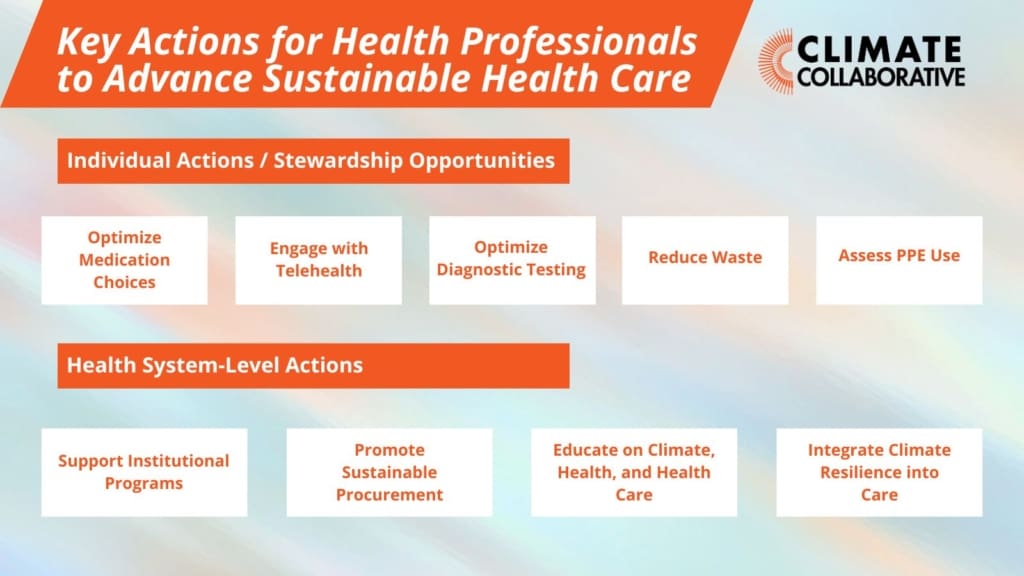Key Actions for Health Professionals to Advance Sustainable Health Care
This shortlist is designed for health professionals in clinics or similar settings who are interested in practical, individual actions to advance sustainable health care in their workplace. It offers a concise set of immediate steps that promote environmentally sustainable practices and encourage clinicians to consider environmental impact in their care decisions. The document begins with five individual action areas where health professionals can take direct steps, followed by four system-level actions where they can work with or support their clinic, practice, or hospital leadership to advance sustainability initiatives and establish supportive programs. View additional system-wide actions for hospitals and health systems to commence or accelerate their journey.

Individual Actions / Stewardship Opportunities
Individual actions should be grounded in primary prevention to improve health, reduce overall health care utilization, and implement resource stewardship principles to match the supply of health services to their needs [1].
Specific individual actions could include:
01
Optimize Medication Choices
Prescribe medications with a sustainability lens – considering different medication types, administration methods, prescribing quantities, deprescribing, patient needs, and optimizing the number of refills to reduce waste emissions. When appropriate, consider non-pharmaceutical treatments [2,3]. Examples include:
- Prioritize oral (or enteral tube-based) medications over intravenous ones when appropriate to reduce waste and emissions [4,5,6].
- Design order sets to prioritize these alternate medication pathways, and promptly transition to oral medications once oral diets are resumed (i.e., after surgery).
- Engage with inpatient pharmacy teams and antimicrobial stewardship programs to identify high-yield opportunities to reduce IV medications.
- Use lower environmental impact alternatives when possible and clinically appropriate. Examples include choosing dry powder inhalers [7,8] over metered-dose inhalers (MDIs), choosing alternatives to desflurane anesthetic gas [7,8], and prescribing nature-based solutions and non-pharmaceutical treatments when applicable and clinically appropriate [9,10,11,12].
- Design clinical decision support systems in electronic health records that support environmentally preferred options and minimize medication waste and emissions.
- Consider prescribing a shorter initial duration (e.g., 30-day supply instead of 90) for starting new medications, before committing to a larger supply, while also considering patient costs and insurance plans that may offer lower co-pays for 90-day orders [3,13].
- Educate patients on the importance of proper disposal of medications, including over-the-counter medications and MDIs [13].
02
Engage with Telehealth
Use telehealth for patient visits, when appropriate, to reduce patient and staff travel, emissions, and resources [14,15,16].
- Consider telehealth for simple visits, such as patient follow-ups for test results [14,16].
- Create easy pathways to simplify scheduling for telephone and video visits [17].
- Encourage patients to identify adjunctive treatments closer to their home (e.g., serial imaging or lab testing, physical or occupational therapy, speech therapy, nutritional therapies, etc.), when appropriate and available, to minimize travel [14,16].
- Consider opportunities for home-based care, including home exercise programs, as alternatives or supplements to programs that require travel [14,16].
03
Optimize Diagnostic Testing
Consult evidence-based practice recommendations to reduce low-value testing and treatments [18].
- Avoid unnecessary testing, particularly when risks to patients and the environment outweigh the potential clinical benefits, such as performing ultrasounds instead of CT or MRI scans [15,19].
- Reduce duplicative lab work by reviewing the need for additional testing based on past results and considering clinical guidelines (e.g., daily PT/INRs, daily labs in inpatient/ICU, and viral panels) [18].
04
Reduce Waste
Implement practices that reduce waste and emissions and conserve resources while maintaining quality and patient safety [20].
- Optimize resource use in clinical workflows by minimizing use of single-use plastics in clinical care when appropriate [21,22]; appropriately sizing surgical, suture, or procedure kits [20,21,22] to avoid unnecessary instruments; and conducting workflow assessments to identify hotspots where plastic waste can be minimized [22].
- Reconsider glove use when performing low-risk examinations on patients who do not otherwise require contact precautions (i.e., chest auscultation, musculoskeletal exams, HEENT exams, etc.). In such situations, proper hand hygiene provides sufficient protection [23].
- Gauge whether patient exams can be performed in the patient’s own garments; where patient garments are necessary, consider reusable options to minimize waste.
- Become familiar with, and if necessary, re-evaluate waste disposal practices to ensure that regulated and non-regulated waste are properly separated and disposed of in the appropriate disposal bins [20].
- Ensure that recyclable, reprocessable, universal, hazardous, and pharmaceutical wastes are disposed of in the appropriate bins, when available [20].
- Reduce printing waste by using digital tools and electronic health records. Re-evaluate the use of disposable paper products, such as exam table paper, when clinically appropriate [20,22].
05
Assess Personal Protective Equipment (PPE) Use
Minimize overuse and inappropriate use of PPE while prioritizing staff and patient safety [24].
- Use organizational protocols and consultations with infection control to determine when contact precautions can be safely discontinued and remove contact precaution signage and materials to avoid unnecessary use [25].
- Collaborate with infection control staff to determine settings and situations for using reusable PPE [24].
Health System-Level Actions
Work with leaders and collaborators within the health system, practice, or clinic to promote commitment to environmental sustainability and emission reduction efforts, create or designate an institutional leader for sustainability initiatives, and help establish relevant programs [20].
Specific system-level actions could include:
01
Support Institutional Programs
Participate in institutional initiatives to reduce waste and emissions. Examples include reducing the use of single-use plastics in clinical care, supporting waste reduction initiatives, increasing medical device reprocessing, integrating sustainability into contracting and procurement processes, and reducing emissions related to employee commutes, such as promoting public transit, biking, online meetings, and consolidated work schedules [20].
02
Promote Sustainable Procurement
Identify and encourage procurement from vendors who prioritize sustainability efforts. Such vendor efforts could include reuse, refurbishment, and single-use device reprocessing programs; use of recycled materials; electronic instructions for use; and clear product labeling for disposal pathways and recycling [20].
03
Educate on Climate, Health, and Health Care
Leverage the trust people have in health professionals to educate peers, trainees, and patients on the health impacts of climate change, how climate and health care intersect, and what opportunities exist to reduce the climate impact of health care delivery [15,26,27,28].
04
Integrate Climate Resilience into Care
Incorporate climate resilience into care plans of patients at higher risk by considering how climate hazards, such as extreme heat, can impact their health conditions and ensure they are prepared for disruptions in care. Encourage organizational leaders to develop and release a climate resilience plan for continuous operations, anticipating and incorporating the expressed needs of groups in the community that experience disproportionate risk of climate-related harm [27,28].
Note: Check out the NAM Climate Journey Map: Clinical Pathway for more in-depth information on how health professionals can lower their organization’s emissions and waste.
References
- Professional Responsibilities for Planetary Health Stewardship
- Reducing the adverse environmental impacts of prescribing
- Minimizing the environmental impact of unused pharmaceuticals: Review focused on prevention
- Effectiveness of antimicrobial stewardship interventions on early switch from intravenous-to-oral antimicrobials in hospitalized adults: A systematic review
- Pharmacoeconomic and antimicrobial stewardship analysis in waste management: Beyond switching drug administration route
- O03 Scale and spread of a quality improvement initiative promoting metronidazole IV to oral switch (IVOST) in the acute hospital setting: antimicrobial stewardship, patient safety, workforce and environmental sustainability benefit
- Clinical prioritization tool for health care decarbonization
- Net zero healthcare: a call for clinician action
- Nature Exposure, Even as Little as 10 Minutes, is Likely to Yield Short-Term Benefits for Adults with Mental Illness: A Meta Analysis
- Restoring Nature = Restoring Ourselves
- Nature Prescriptions for Health: A Review of Evidence and Research Opportunities
- Nature Rx: Nature prescribing in general practice
- Waste-minimising measures to achieve sustainable supply and use of medication
- Estimated Carbon Emissions Savings with Shifts from In-Person Visits to Telemedicine for Patients with Cancer
- Tackling Climate Change: Health Professionals Do More Using Less
- The potential of virtual healthcare technologies to reduce healthcare services’ carbon footprint
- Optimizing teleconsultation scheduling to make healthcare greener
- Choosing Wisely Canada Recommendations
- Sustainability in healthcare by reducing low-value imaging – A narrative review
- NAM – Key Actions to Reduce Greenhouse Gas Emissions by U.S. Hospitals and Health Systems
- Health Care Actions for Reducing Plastic Use and Pollution
- A Pragmatic Approach to Streamlining Single-Use Plastics in Health Care
- NHS England ‘The gloves are off’ campaign
- Innovations and development of sustainable personal protective equipment: a path to a greener future
- Duration of Contact Precautions for Acute-Care Settings | Infection Control & Hospital Epidemiology
- The Role of Clinicians in the Climate Crisis
- How Clinicians Can Lead Climate Action to Protect Patients and the Planet
- Tackling climate change: the pivotal role of clinicians
Support
The funding support extended by the NAM Climate Collaborative’s sponsors makes work like this possible. See full list of sponsors.
Disclaimer
This resource was prepared by Komal Bajaj (NYC Health + Hospitals), Hardeep Singh (Baylor College of Medicine), Laura Bellaire (University of Utah Health), Amy Collins (Health Care Without Harm), Todd Sack (Physicians for Social Responsibility), Katie Huffling (Alliance of Nurses for Healthy Environments), Heather Massey (My Green Doctor), and Chris Lemon (Johns Hopkins), who are members of the Health Care Delivery or Health Professional Education & Communication Working Groups of the NAM Climate Collaborative; and reviewed by members of the Collaborative. Statements in this resource do not necessarily reflect the views of all members of the Climate Collaborative; the NAM; or the National Academies of Sciences, Engineering, and Medicine (National Academies). The document is intended to help inform and stimulate discussion. It is not a report of the NAM or the National Academies. Copyright by the National Academy of Sciences. All rights reserved.
External Review Group
Wynne Armand, MD
Massachusetts General Hospital
Ryan Beechinor, PharmD, BCPS, BCOP
Senior Pharmacist, Hematology/Oncology
UC Davis Comprehensive Cancer Center
Assistant Professor, UCSF School of Pharmacy
Assistant Professor, UC Davis School of Medicine
Karen Brown, MD
Internist, Medical Director, and Vice Chief for the Community, Section of General Internal Medicine
Yale New Haven Health
IM Yale New Haven health
Flora Lum, MD
American Academy of Ophthalmology
Christine Murphy, MA
Chief Policy Officer, American Academy of Nursing
Rebecca Philipsborn, MD, MPA
Emory University School of Medicine
Related Products

